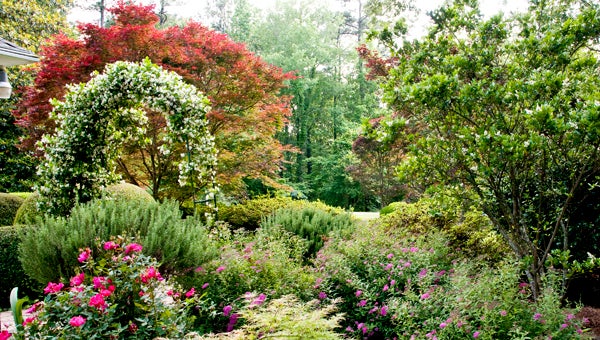Deborah Elliott shares insight into gardening
Published 10:51 am Tuesday, February 16, 2016

A view of the upcoming springtime abundance in the yard of Deborah and Lou Elliott. Though mainly Deborah’s project, Lou is allowed to help with raking and watering—the bulk of the low-maintenance requirements. (Contributed)
By LAURA BROOKHART / Community Columnist
In 1985, Lou and Deborah Elliott moved into the original Dearing family home (as in Dearing Downs) tucked back on 3.5 acres at a dead end surrounded by huge oak trees and woods.
They brought with them a potted Japanese maple that they called their ‘marriage tree,’ and soon added several other “twig-size” Japanese maples to keep it company. Today some 13 Japanese maples, including a Butterfly Japanese Maple and Acer palmatum ‘Orido Nishiki‘bring various shades of red, orange, gold and even pink to the yard throughout the season.
A 1990 tornado felled giant oaks all around the house, seriously damaging the roof and giving the Elliotts an opportunity to remodel, and in spite of the chaotic debris, not one limb of their marriage tree was damaged!
Deborah has divided her garden areas with paths and named each. There is the Front Garden, The Lady Garden, named for a weathered statue, and its path meanders beyond through the Hydrangea Walk.
There, Deborah honors her mother, Annabelle, with the large white flowering Hydrangea arborescens Annabelle.
The Woodland Garden to the right of the front drive is introduced by a Deodar Cedar ‘Feelin’ Blue,’ an eye-catching specimen of blue-green that sets off the warmer plant colors. Interspersed are spreading yew and Heuchera macrorhiza ‘Autumn Bride,’ a hardy shade plant that also provides cut flowers.
Deborah has established lush moss-covered pathways and installed a small bridge painted a cool, but contrasting accent color.
Since 2009, Deborah has been writing a blog that includes many photographs taken year round.
Most recently she wrote, “I do not commit crape murder! I prune a crape myrtle so that it is allowed to grow into its naturally beautiful tree form. Unfortunately, I still see crape myrtles that have been chopped back to large stubs, a practice that promotes ugly knots and lots of weak sprouts.”
“I felt a rush of satisfaction as I removed dead branches, shaped and cut wayward shoots from crape myrtles and apple trees. They look great now and are ready for a new season of growth.”
“There is much to do as spring approaches — the world is wakening!”
Check out more of Deborah’s gardening tips and a link to her podcast at: Debsgarden.squarespace.com/.








